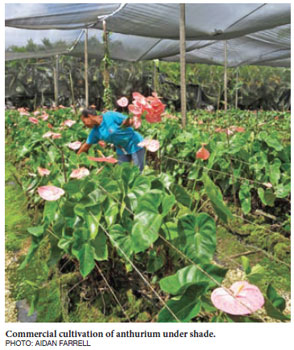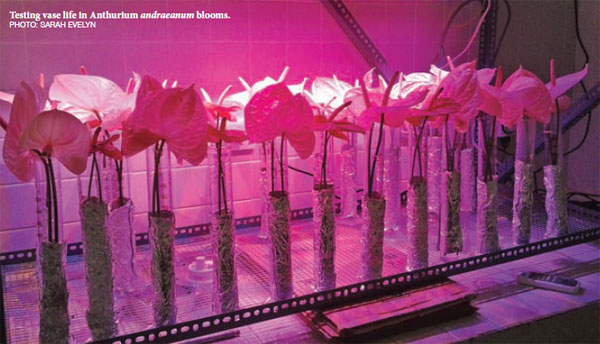|
April 2016

Issue Home >>
|

 At its peak, anthurium production was a profitable industry, but recently it has been in decline. A lack of organization and strategic planning and information for farmers, has contributed to this decline. Many of the factors influencing the flower trade are external to Trinidad and Tobago, but some are related to the anthurium blooms themselves, such as poor adaptability, susceptibility to diseases and nematodes, lack of novelty, and short vase-life of showy varieties. At its peak, anthurium production was a profitable industry, but recently it has been in decline. A lack of organization and strategic planning and information for farmers, has contributed to this decline. Many of the factors influencing the flower trade are external to Trinidad and Tobago, but some are related to the anthurium blooms themselves, such as poor adaptability, susceptibility to diseases and nematodes, lack of novelty, and short vase-life of showy varieties.
This is where The UWI anthurium group finds its niche. The goal of the group is to provide research and development, education and training support, towards the development of a well-organized, globally competitive Caribbean anthurium industry.
Research has been carried out on many of the issues affecting the regional anthurium industry, including disease resistance, nematode infestations, spathe colour and vase life.
Disease Resistance
The anthurium industry has been battling with bacterial blight disease (Xanthomonas campestris pv. dieffenbachiae). Symptoms of the disease include water-soaked leaf spots with a dark centre and yellow halo, chlorosis of the leaf and yellowing of older leaves and petioles. This causes the infected leaf or flower to lose its peduncle, revealing dark brown streaks at the breakage point. Measures of chemical and physical control are expensive, whereas developing resistant varieties is a more sustainable approach. But the genetics of resistance must be understood and suitable screening methods should be implemented. Studies on optimizing screening methods have been conducted over the last ten years and disease-resistant varieties were developed. The screening method for bacterial blight resistance has now been patented by Dr. Winston Elibox and Prof. Pathmanathan Umaharan at The UWI.
Roundworm infestation
Nematodes or roundworms are tiny multicellular organisms and are adapted to almost all environments. There are thousands of species; several of which are parasitic. Burrowing nematodes cause major problems in several crops.
“The nematode species that we get here in Trinidad can result in low productivity in anthuriums,” says postgraduate student, Nadine Ali. Older roots are affected by root rot and become brown or black. The older roots are mostly affected; however the functionality of the new roots is reduced until there are fewer new roots, and the eventual death of the root system. This leads to the classic symptoms of nutrient deficiencies such as yellowing of leaves and smaller plants producing fewer blooms. Again, chemical and physical controls are expensive and tedious to apply. Thus, “genetic resistance may be the key to dealing with the issue of nematodes. This would involve the development of new breeding strategies and nematode-resistant varieties,” says Ms. Ali.
Spathe colour
“The anthurium industry thrives on novelty; consumers are constantly seeking excitement and variety. Spathe colour is an important component that influences consumer preference for anthurium cut-flowers, and to effectively respond to the seasonal demand, the industry needs a wide range of colours. The Netherlands maintain their competitive advantage on the international market because they are the world’s largest breeder and therefore the source of most new colours and patterns obtained through interspecific hybridization. Currently the common spathe colours of anthurium include red, pink, orange, coral and white. However, green, brown and maroon spathes exist as well as “obakes” which are spatial bi-colours with green lobes and coloured centres. Research has been ongoing at The UWI to develop new spathe colours and patterns in tropically-adapted and commercially competitive anthurium varieties. These novel colours and patterns would give regional producers a competitive edge and allow them to acquire higher premiums for their cut flowers. This would assist in revitalizing the industry in the Caribbean,” says PhD student, David Gopaulchan.
Vase life
 The “end of vase life” is used by producers to describe cut flowers that have lost quality so that they are no longer marketable. There are several signs of the end of vase life and these vary between species and between varieties. In anthuriums, spadix browning and spathe browning, discolouration, floppiness and loss of gloss are a few signs. Many new anthurium varieties produced for disease resistance and tropical adaptability have not been evaluated for vase life. Several blooms which fit the florist’s preference of showy spathe and bright colour have very short vase lives. Vase life in anthurium varies from less than two weeks to more than six weeks, but only those blooms lasting more than three weeks are suitable for the export markets. This creates challenges for exportation and international competiveness. We are conducting work to identify the physiological mechanisms responsible for variation in vase life in anthurium varieties. The “end of vase life” is used by producers to describe cut flowers that have lost quality so that they are no longer marketable. There are several signs of the end of vase life and these vary between species and between varieties. In anthuriums, spadix browning and spathe browning, discolouration, floppiness and loss of gloss are a few signs. Many new anthurium varieties produced for disease resistance and tropical adaptability have not been evaluated for vase life. Several blooms which fit the florist’s preference of showy spathe and bright colour have very short vase lives. Vase life in anthurium varies from less than two weeks to more than six weeks, but only those blooms lasting more than three weeks are suitable for the export markets. This creates challenges for exportation and international competiveness. We are conducting work to identify the physiological mechanisms responsible for variation in vase life in anthurium varieties.
“Once the physiological characteristics have been identified, the genes responsible for variation in vase life can be isolated” says Dr. Aidan Farrell. Manipulation of these genes by breeding or genetic engineering can then be carried out to extend the vase life of short-lived cultivars.
Several technological developments have been implemented in anthurium research at The UWI. For example, the Biotechnology Unit of the Department of Life Sciences has developed a protocol for optimisation of anthurium transgenics through micropropagation and transformation.
With all this research, who can say what anthurium blooms will look like ten years from now? For further information please visit the UWI anthurium website at http://sta.uwi.edu/anthurium/.
Sarah Evelyn is a laboratory technician in the Biotechnology Unit and an MPhil candidate researching the extension of vase life in anthuriums with the Department of Life Sciences, at UWI, St. Augustine.
The Department of Life Sciences, in collaboration with other Departments of the Faculty of Science and Technology, will be hosting a Research Symposium from April 7-8, 2016, at C1 room of the Chemistry Building at the St. Augustine Campus. An update on current anthurium research will be presented at this event. For further information, please email lifesci.symposium@sta.uwi.edu
|





